Search
Remove Ads
Advertisement
Summary 
Loading AI-generated summary based on World History Encyclopedia articles ...
Search Results
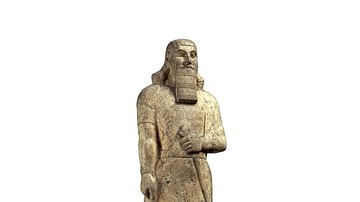
Definition
Ashurnasirpal II
Ashurnasirpal II (r. 884-859 BCE) was the third king of the Neo-Assyrian Empire. His father was Tukulti-Ninurta II (r. 891-884 BCE) whose military campaigns throughout the region provided his son with a sizeable empire and the resources to...
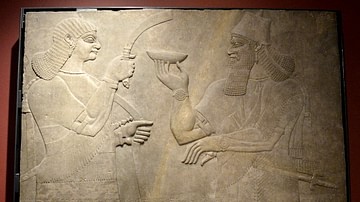
Article
The Greatest Party Ever Thrown: Ashurnasirpal II’s Kalhu Festival
The greatest party ever thrown in antiquity is the inaugral event thrown by Ashurnasirpal II (r. 884-859 BCE) in 879 BCE at the completion of his new city of Kalhu which was attended by almost 70,000 people who were served, among other treats...
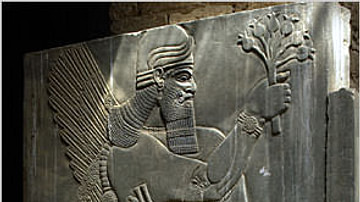
Article
The Banquet Stele of Ashurnasirpal II
When he came to the throne in 884 BCE, Ashurnasirpal II had to attend to revolts which broke out across the empire. He ruthlessly put down all rebellions, destroyed the rebel cities and, as a warning to others, impaled, burned, and flayed...
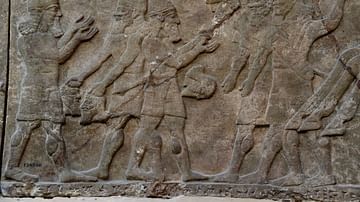
Article
Wall Reliefs: Ashurnasirpal II's War Scenes at the British Museum
The Mighty King 600 of their warriors I put to the sword and decapitated; 400 I took alive; 3,000 captives I brought forth; I took possession of the city for myself: the living soldiers, and heads to the city of Amidi the royal city, I sent...

Image
Ashurnasirpal II Attacking Enemy Archers
Gypsum wall panel relief showing Ashurnasirpal II in his chariot attacking the archers of the enemy. Above his horses is the emblem of the god Assur (also shooting arrows). 865-860 BCE.
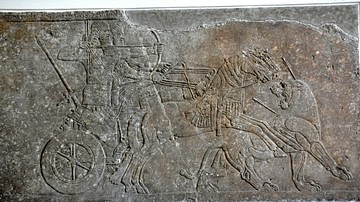
Image
Ashurnasirpal II Lion Hunting
Gypsum wall relief depicting a classical Assyrian lion-hunting scene. The striking feature is that the king wears a diadem with a rosette on it, instead of the typical conical headcap of the Assyrian kings. From the North-West Palace at Nimrud...
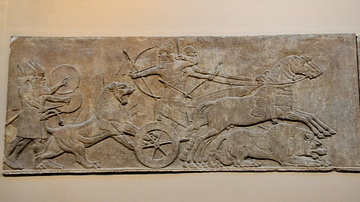
Image
Ashurnasirpal II Hunting Lions
This gypsum wall relief depicts a typical Assyrian lion-hunting scene. King Ashurnasirpal II stands in his royal chariot and shoots at a leaping wounded lion. Two royal attendants, behind the wounded lion, holding their shields and daggers...
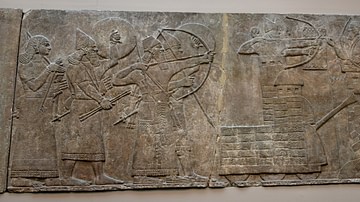
Image
Ashurnasirpal II Attacks a City
Alabaster bas-relief depicting a war scene. Neo-Assyrian Period, 865-860 BCE. Panel 18 (top) of Room B, the North-Palace Palace, Nimrud, modern-day Iraq. (The British Museum, London)
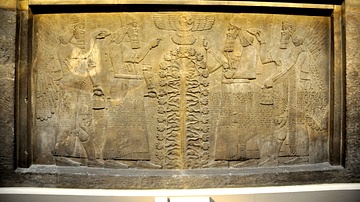
Image
Ashurnasirpal II Prays Before the Sacred Tree and the God Shamash
The Assyrian king appears to raise his right hand and point his right index finger in a gesture of worship. He holds a mace, the symbol of authority. The Sacred Tree (which is probably a palm tree) lies at the middle of the relief. The king...
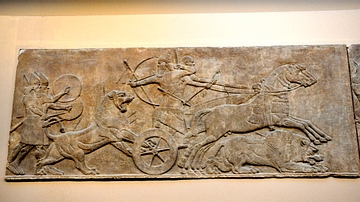
Image
Ashurnasirpal II hunts lions
In this wall relief, the Assyrian King Ashurnasirpal II stands in a royal chariot and hunts lions. Neo-Assyrian era, 865-860 BCE. From Room B (the throne room), North-West palace at Nimrud (ancient Kalhu; Biblical Calah), northern Mesopotamia...